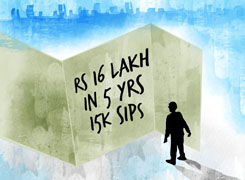Ramalingam Kalirajan |10893 Answers |Ask -Follow
Mutual Funds, Financial Planning Expert - Answered on Jul 10, 2024
He has an MBA in finance from the University of Madras and is a certified financial planner.
He is the director and chief financial planner at Holistic Investment, a Chennai-based firm that offers financial planning and wealth management advice.... more

Hi , i am 31 year old working women and i earn 35K per month, i have two children age 9 and 5 year. i would like to invest in SIPs of Rs 5000 each for my children for 15 year and 20 year respectively and Rs 5000 per month for my retirement, Kindly guide which SIP would be best suited for my purpose.
Your Current Financial Situation
Monthly Income: Rs 35,000
Monthly Investment Plans:
SIP for Child 1 (15 years): Rs 5,000
SIP for Child 2 (20 years): Rs 5,000
SIP for Retirement: Rs 5,000
You have allocated Rs 15,000 monthly towards investments, which is a commendable step.
Setting Clear Financial Goals
Your goals are well-defined: securing your children’s future and ensuring a comfortable retirement. Let’s delve into how SIPs can help you achieve these goals.
Importance of Systematic Investment Plans (SIPs)
SIPs are an excellent way to invest in mutual funds. They allow you to invest a fixed amount regularly, bringing discipline to your savings. SIPs also leverage the power of compounding and rupee cost averaging, which helps in accumulating wealth over time.
Understanding Different Types of Mutual Funds
Equity Funds: These invest in stocks and are suitable for long-term goals like your children’s education and your retirement. They offer higher returns but come with higher risk.
Debt Funds: These invest in bonds and are suitable for short-term goals or as a safer investment option. They offer lower returns but with lower risk.
Hybrid Funds: These invest in both equities and debt, providing a balanced risk-return profile. They can be a good option for moderate risk tolerance.
Power of Compounding
Compounding is a powerful concept in investing. It means earning returns on your initial investment as well as on the accumulated returns over time. Starting early and staying invested maximizes the benefits of compounding.
Risk Management in Investments
Investing always involves some level of risk. Understanding and managing these risks is crucial to achieving your financial goals.
Equity Funds: High risk, high return. Best for long-term goals.
Debt Funds: Low risk, low return. Best for short-term goals.
Hybrid Funds: Medium risk, balanced return. Suitable for moderate risk tolerance.
SIPs for Your Children’s Education
You want to invest Rs 5,000 each for 15 and 20 years for your children’s education. Let’s explore the best strategies for these investments.
Long-Term Growth with Equity Funds
For a 15-year and a 20-year investment horizon, equity funds are ideal. They offer the potential for higher returns, which is crucial for long-term goals like education.
Benefits of Equity Funds
Higher Returns: Equity funds have the potential to deliver higher returns over the long term.
Diversification: These funds invest in a diversified portfolio of stocks, spreading risk across various sectors and companies.
Professional Management: Managed by professional fund managers who make informed investment decisions.
SIPs for Your Retirement
You want to invest Rs 5,000 monthly for your retirement. Given your long-term horizon, equity funds are again a suitable option.
Maximizing Retirement Corpus
To build a substantial retirement corpus, investing in equity funds can be highly beneficial due to their high return potential. Over a long period, the compounding effect will significantly increase your savings.
Evaluating Actively Managed Funds
Actively managed funds can be more beneficial than index funds. They aim to outperform the market by selecting the best stocks.
Disadvantages of Index Funds
Lower Returns: Index funds typically provide lower returns compared to actively managed funds.
Lack of Flexibility: They replicate a market index and cannot adjust to market conditions.
Benefits of Actively Managed Funds
Higher Returns: Aim to outperform the market by picking the best stocks.
Professional Management: Managed by experienced fund managers who can adapt to market changes.
Creating a Balanced Investment Portfolio
Diversifying your investments across different types of mutual funds can help manage risk and optimize returns. Here’s a suggested allocation:
Equity Funds: For long-term growth.
Hybrid Funds: For balanced risk and returns.
Debt Funds: For stability and short-term goals.
Regular Review and Rebalancing
Investing is not a one-time activity. Regularly reviewing and rebalancing your portfolio is essential to ensure it aligns with your goals and risk tolerance.
Recommendation: Review your investments at least once a year. Rebalance if necessary to stay on track with your financial goals.
Surrendering Investment-Cum-Insurance Policies
If you hold any LIC or ULIP policies, consider surrendering them. These policies often provide lower returns compared to mutual funds. Reinvest the proceeds into mutual funds for better growth.
Strategic Financial Plan
Let’s create a strategic financial plan to help you achieve your goals:
Step 1: Emergency Fund
Before increasing investments, ensure you have an emergency fund. This fund should cover at least six months of expenses. It provides a safety net for unexpected expenses.
Step 2: Investing in SIPs
Continue with your SIPs for your children and retirement. Gradually increase the SIP amount as your income grows.
Step 3: Diversifying Investments
Invest in a mix of equity, hybrid, and debt funds to balance risk and returns.
Step 4: Regular Review
Review and rebalance your portfolio regularly to ensure it aligns with your goals and risk tolerance.
Final Insights
You’re on the right path with your investment plans. To secure your children’s future and ensure a comfortable retirement, focus on increasing your SIP contributions, diversifying your investments, and regularly reviewing your portfolio. Equity funds, with their high return potential, are suitable for your long-term goals. Keep leveraging the power of compounding to maximize your savings.
Your dedication to planning ahead is commendable. Continue making informed decisions to secure a worry-free future for you and your children.
Best Regards,
K. Ramalingam, MBA, CFP,
Chief Financial Planner,
www.holisticinvestment.in
You may like to see similar questions and answers below
Ramalingam Kalirajan |10893 Answers |Ask -Follow
Mutual Funds, Financial Planning Expert - Answered on Jan 30, 2024
Ramalingam Kalirajan |10893 Answers |Ask -Follow
Mutual Funds, Financial Planning Expert - Answered on Jul 11, 2025
Ramalingam Kalirajan |10893 Answers |Ask -Follow
Mutual Funds, Financial Planning Expert - Answered on Dec 15, 2025
Ramalingam Kalirajan |10893 Answers |Ask -Follow
Mutual Funds, Financial Planning Expert - Answered on Dec 15, 2025
Radheshyam Zanwar |6746 Answers |Ask -Follow
MHT-CET, IIT-JEE, NEET-UG Expert - Answered on Dec 15, 2025
Ramalingam Kalirajan |10893 Answers |Ask -Follow
Mutual Funds, Financial Planning Expert - Answered on Dec 15, 2025
Ramalingam Kalirajan |10893 Answers |Ask -Follow
Mutual Funds, Financial Planning Expert - Answered on Dec 15, 2025
Ramalingam Kalirajan |10893 Answers |Ask -Follow
Mutual Funds, Financial Planning Expert - Answered on Dec 15, 2025
Samraat Jadhav |2508 Answers |Ask -Follow
Stock Market Expert - Answered on Dec 15, 2025
Ramalingam Kalirajan |10893 Answers |Ask -Follow
Mutual Funds, Financial Planning Expert - Answered on Dec 15, 2025
Reetika Sharma |425 Answers |Ask -Follow
Financial Planner, MF and Insurance Expert - Answered on Dec 15, 2025
Radheshyam Zanwar |6746 Answers |Ask -Follow
MHT-CET, IIT-JEE, NEET-UG Expert - Answered on Dec 15, 2025























